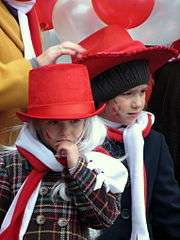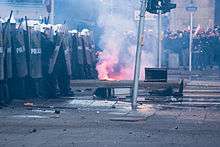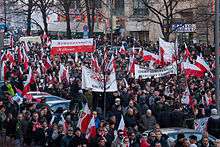National Independence Day (Poland)
| National Independence Day | |
|---|---|
|
Historical reconstruction of Polish soldiers, who fought for independence in the November Uprising (1830-1831), parading along Warsaw's Royal Route | |
| Observed by | Poland |
| Significance | To commemorate the recovery of a sovereign state by the Poles in 1918 |
| Celebrations | fireworks, family reunions, concerts, parades |
| Date | 11 November |
| Next time | 11 November 2018 |
| Frequency | Annual |
National Independence Day (Polish: Narodowe Święto Niepodległości) is a national day in Poland celebrated on 11 November to commemorate the anniversary of the restoration of Poland's sovereignty as the Second Polish Republic in 1918 from the German, Austrian and Russian Empires. Following the partitions in the late 18th century, Poland ceased to exist for 123 years until the end of World War I, when the destruction of the neighbouring powers allowed the country to reemerge. It is a non-working day in Poland.
Significance of the date
.jpg)
The restoration of Poland's independence was gradual. The 11 November date chosen is the one on which Marshal Józef Piłsudski assumed control of Poland.[1][2] The holiday was constituted in 1937 and was celebrated only twice before World War II. After the war, the communist authorities of the People's Republic removed Independence Day from the calendar,[3] though reclamation of independence continued to be celebrated informally on 11 November. The holiday was officially replaced by the National Day of Poland's Revival as Poland's National Day, celebrated on the 22 July anniversary of the communist PKWN Manifesto under Joseph Stalin. In particular, during the 1980-ties, in many cities, including Warsaw, informal marches and celebrations were held, with the outlawed Solidarity Movement supporters participating. Typically these marches were brutally dispersed by the communist militarized police forces, with many participants arrested and often tortured by the security police. During this time the November 11th Independence Day marches, alongside the Constitution Day on May 3rd celebration gatherings, also banned by the communist authorities, were the customary dates of demonstrations by the opponents of the communist regime. As Poland emerged from communism in 1989, the original holiday—on its original 11 November date—was restored.[4]
The date corresponds to the date of other countries' Remembrance Day, Armistice Day, or Veterans Day.[5] All of these holidays and Polish Independence Day are indirectly related because they all emerged from the circumstances at the end of World War I. In other countries, holidays were established in the spirit of grief and horror at the enormous human cost of the war, and they mark the sacrifices of those who fought. For Poland, however, the tragedy of the war was tempered by what had been accomplished at its end: the restoration of a sovereign Polish state that had been lost entirely in the partitions of Poland, after 123 years of struggle.[6] The Polish holiday is therefore simultaneously a celebration of the reemergence of a Polish state and a commemoration of those who fought for it.
_7.jpg)
Historical meaning
Crucial to restoring independence was the defeat in the war of all three of the occupying powers.[7] Russia was plunged into the confusion of revolution and civil war, Austria-Hungary disintegrated and went into decline, and the German Empire bowed to pressure from the forces of the Entente.[8] For Poles, this was a unique opportunity to reclaim their independence.
Following the defeat of the occupying forces, the Poles seized military and civil power, building the foundations of their future state. On 28 October 1918 the Polish Liquidation Commission was formed in Kraków. The Commission seized power from the Austrians in Galicia and Cieszyn Silesia.[9] A few days later they succeeded in disarming the Austrian forces using members of the secret Polish Military Organisation as well as legionnaires and young people. On the nights of 6 and 7 November the Provisional Government of the People's Republic of Poland was formed in Lublin under the supervision of Ignacy Daszyński.[10] The government was made up of representatives from the Polish Socialist Party (PPS), the Polish Social Democratic Party (PPSD) and the Polish People's Party "Wyzwolenie" (Liberation). At the same time the Government troops disarmed the occupying forces around the city of Kielce and Lublin. It was at this point that the country's future head of state, Józef Piłsudski, returned to Poland after incarceration by the Germans. His 10 November arrival in Warsaw was enthusiastically met by the population of the capital and saw the mass disarmament of the occupying forces across the whole of Poland. Piłsudski assumed authority on 11 November,[10] forming a new centralized government and soon calling parliamentary elections.
Notable dates in history

- 5 November 1916 – Act of November 5th was released in order to create the Regency Kingdom of Poland
- 14 January 1917 – Provisional Council of State had started its activity
- 12 November 1917 – Regency Council took over the head of state duties
- 7 October 1918 – Regency Council announced Poland's independence
- 23 October 1918 – government with the prime minister Józef Świeżyński was established, without approval by the German authorities
- 1 November – branches of the Polish Military Organization began disarming German and Austrian soldiers
- 6/7 November 1918 – in Lublin, Ignacy Daszyński established a Provisional Government of the People's Republic of Poland
- 10 November 1918 – Józef Piłsudski came to Warsaw, previously released from prison in Magdeburg.
- 11 November 1918 – Piłsudski was appointed Commander in Chief by the Regency Council and was entrusted with creating a national government for the restored Polish State.
- 16 November – Józef Piłsudski signed a telegram notifying the creation of an independent Polish State. The telegram was sent by radio to the leaders of the superpowers and to all of the warring or neutral governments three days later with the use of equipment from the Warsaw Citadel, just after exiting the German troops.
- 17 November – after the resignations of Ignacy Daszyński, Józef Piłsudski appointed Jędrzej Moraczewski as the prime minister.[11]
Controversies

Starting in 2008 on 11 November in Warsaw selected nationalist organizations participated in a "March of Independence" launched by the far-right National Radical Camp (ONR) and All-Polish Youth leading to notable violent incidents and arrests. During the 2012 clashes between extremists and the police, 176 rioters were detained and 22 police officers wounded.[12][13][14] In 2013 a group of 72 far-right hooligans were detained and 12 police officers taken to hospital. Damages to private and public property by the masked youth was estimated at 120,000 zł.[15] Significant act of vandalism included the burning of the LGBT "Tęcza" Rainbow Arch at a Warsaw square,[15] others took place near the Russian embassy.[16] The unofficial march was declared illegal by the authorities and the city.[16] As of April 2014 administrative courts continue to analyze evidence.[17]

However, the desire for street celebrations has already been expressed by the public. In 2011 over 20,000 people took place in a daytime march in different cities, preceding the nighttime clashes in Warsaw. In response, the President of Poland Bronisław Komorowski proposed in 2011 that he will lead the new official Independence March in 2012. His offer was backed by the ruling PO and PSL coalition, but opposed by the nationalists.[18][19]
As of 2012 there is a popular and all-inclusive march taking place in Warsaw led by the President under the name "Razem dla Niepodległej" ("Together for the Independent"). It is considered a continuation of the official ceremonies of the anniversary, and accompanied by patriotic displays and songs. The number of participants in the 2012 Presidential march was estimated at 10,000.[20][21][22][23][24][25][26]
Meanwhile, the violent incidents were heavily covered in the Polish media, with commentators criticizing the lack of leadership on the part of the government in the face of the extremity of the far-right rhetoric. The media coverage is seen as selective and unduly focused on riots instead of the Presidential march which is in no way connected with them.[27][28][29][30]
In 2017, 60,000 people marched in a procession organized by the ONR and other far-right groups,[31] chanting "Death to enemies of the homeland" and "Catholic Poland, not secular".[32]
The slogan of the march was "We want God", which comes from an old Polish nationalist song and a phrase quoted by US President Donald Trump during his visit to Poland earlier in the year.[33]
See also
References
- ↑ "The beginning of independence" (in Polish). Museum of Józef Piłsudski in Sulejówek. Retrieved 19 December 2013.
- ↑ "The declaration of independence" (in Polish). Museum of Józef Piłsudski in Sulejówek. Retrieved 19 December 2013.
- ↑ "November 11 in non-sovereign, and sovereign Poland" (in Polish). Museum of Józef Piłsudski in Sulejówek. Retrieved 19 December 2013.
- ↑ "Polish Independence Day - Office Holidays". www.officeholidays.com. Retrieved 13 November 2017.
- ↑ "National Independence Day ⋆ Your Roots in Poland". 11 November 2015. Retrieved 13 November 2017.
- ↑ Further information can also be found in sources cited in the articles linked to here, as well as in standard resources on Polish history, such as Norman Davies (1984). Heart of Europe: The Past in Poland's Present. Oxford: Oxford University Press. .
- ↑ "Poland celebrates 99th anniversary of independence - The Krakow Post". 11 November 2017. Retrieved 13 November 2017.
- ↑ Henryk Zieliński (1984). "The collapse of occupiers authority in Polish territories (...)". History of Poland 1918–1939 (in Polish). Warsaw: Polish Scientific Publishers PWN. pp. 84–88. ISBN 83-01-03866-7.
- ↑ Błesznowski, Bartłomiej (13 November 2017). "Cooperativism and Democracy: Selected Works of Polish Thinkers". BRILL. Retrieved 13 November 2017 – via Google Books.
- 1 2 "November 11 - Piłsudski, Daszyński, and Independence Day in Poland - Inside-poland.com". inside-poland.com. Retrieved 13 November 2017.
- ↑ "Calendar of independence 1918–1919" (in Polish). Museum of Józef Piłsudski in Sulejówek. Retrieved 19 December 2013.
- ↑ Interia.pl, 176 zatrzymanych po marszu niepodleglosci (176 detained). Fakty.Interia.pl (in Polish)
- ↑ BBC, "Poland Independence Day march turns violent." The BBC, 11 November 2012.
- ↑ Rzeczpospolita. "Marsz policjantow w kominiarkach" (in Polish).
- 1 2 WP.pl, Po marszu Policja analizuje nagrania z monitoringu (Videotapes analyzed by Police). (in Polish)
- 1 2 "Zdelegalizowany "Marsz Niepodległości" dotarł do mety". Retrieved 13 November 2017.
- ↑ "Decyzja o rozwiązaniu Marszu Niepodległości podważona przez sąd". Retrieved 13 November 2017.
- ↑ Gazeta.pl, March of Independence with the President (in Polish)
- ↑ SE.pl, President will lead the March of Independence (in Polish)
- ↑ RP.pl, Z prezydentem "Razem dla Niepodległej" Presidential march. PAP 2012. (in Polish) "Według wstępnych szacunków służb porządkowych, w prezydenckim marszu uczestniczyło ok. 10 tys. osób."
- ↑ Prezydent.pl, Marsz razem dla Niepodleglej. Office of the President of Poland. (in Polish)
- ↑ SE.pl, Uczestnicy: kto idzie w tym-marszu Wydarzenia: Kraj. Kalendarz Kancelarii.(in Polish)
- ↑ WP.pl, Prezydent prowadzi marsz Razem dla Niepodleglej. 2012-11-11. (in Polish)
- ↑ Wprost.pl, Swieto Niepodleglosci relacja minuta po minucie. Wprost 46/2014. (in Polish)
- ↑ TVN24.pl, Walczyc z wrogami polskosci az do ich ostatniego tchnienia. (in Polish)
- ↑ HFHR.pl, Raport z obserwacji zgromadzen 11 listopada 2012 (PDF file, direct download). (in Polish)
- ↑ Salon24, Prowokacja i zimna krew. (in Polish)
- ↑ KurierPlus.com, Antypolska prowokacja. (in Polish)
- ↑ Eugeniusz Sendecki, Tajemnice nieudanej prowokacji, Neon24.pl (in Polish)
- ↑ Newsweek (11-11-2014), Marsz Niepodległości 2014 dobiegł końca Newsweek.pl Polska (Internet Archive). Since year 2015 after change of government there were no any incidents reported during the march due to less confrontational approach of police.
- ↑ "60,000 join far-right march on Poland's Independence Day". CBC News. Associated Press. 11 November 2017. Retrieved 11 November 2017.
- ↑ Day, Matthew (12 November 2017). "Nationalist protesters disrupt Poland independence day events". Warsaw: CNN. Retrieved 12 November 2017.
- ↑ Specia, Megan (11 November 2017). "Nationalist March Dominates Poland's Independence Day". The New York Times. Retrieved 11 November 2017.
Historical bibliography
- Henryk Zieliński (1984). "The collapse of occupiers authority on Polish territories and the first attempts to create the Polish authority centers (X–XI 1918)". History of Poland 1918–1939 (in Polish). Warsaw: Polish Scientific Publishers PWN. ISBN 83-01-03866-7.
External links
